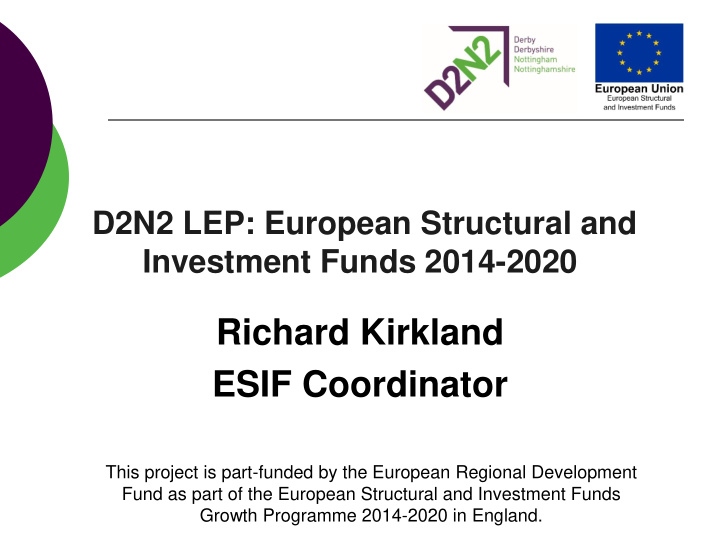



D2N2 LEP: European Structural and Investment Funds 2014-2020 Richard Kirkland ESIF Coordinator This project is part-funded by the European Regional Development Fund as part of the European Structural and Investment Funds Growth Programme 2014-2020 in England.
Purpose of the Presentation To give an overview of the ESIF Programme in • D2N2 To give an overview of the ESIF application • process To explain the governance and partnership • arrangements involved in managing and delivering the programme To explain the ‘route to market’ for projects • To give an opportunity to seek further clarification • and network
Basics for the current PA5 and 6 calls Minimum project value £1 million • Intervention rate is 50% - £500,000 • Call closes Friday 27 May 2016 • Applications need to clearly demonstrate how • activity meets PA requirement • contributes to delivery outputs • Meets local need as set out in the D2N2 ESIF • strategy
ESIF in D2N2 A local ESIF 2014-2020 strategy for ; £98m ERDF (European Regional Development Fund): Supporting business, particularly SMEs £98m ESF (European Social Fund) Supporting people with employment and skills £5.3m EAFRD (European Agricultural Fund for Rural Development) Supporting economic growth in rural areas Bring partners together to oversee’ implementation and spend through its ESIF Programme Board
D2N2 ERD Funding by Priority Axis PA1 Innovation - £18.2m PA2 ICT - £12.3m PA3 – SME competitiveness - £34.8m PA4 – Low Carbon - £22.6m PA5 – Climate change - £4.9m PA6 – Environment / Resource efficiency - £4.7m Nationally low take up for PA4 and PA6 Issues around clarity of eligibility and quality of applications submitted
What will ESIF buy in D2N2 ESIF has specific outputs and outcomes: D2N2 have set the following broad targets for the programme: 5000 businesses receiving support – e.g. ICT, low carbon, SME competitiveness, innovation 400 new enterprises supported 15,000 people supported to find employment 8,000 people supported in relation to social inclusion 2,500 businesses improving skill levels
D2N2 Targets and Progress Targets which must be met within this programme N+3 targets measured annually from 2018 across the whole programme Performance target financial – measured in 2018 and 2023 across programme and by PA level Performance targets non financial – measured in 2018 and 2023 across programme and by PA level
D2N2 Key Challenges Huge demand for PA3 in D2N2 and nationally General lack of match funding at required levels for this programme Ensuring delivery against performance targets with the first milestone in 2018 Changes to exchange rate Pressure therefore in developing high quality proposals that meet these challenges
Key issues from PA4 call Minimum £1m projects required Finance and nature of match i.e. what is eligible. State aid rules and interpretation SME inertia – cant see ROI Ineligible activity e.g. retrofit Lack of alignment with D2N2 ESIF strategy and Core delivery principles
PA6f Resource Efficiency Priorities Support and advice to businesses to improve resource efficiency and improve competitiveness Support or businesses in adaption of innovative technologies ( includes water and waste recycling and recovery) Piloting and demonstrating innovative technologies to promote resource efficiency
PA6f Key challenges SME inertia Uncertainties over benefits of adopting efficiency measures Decoupling economic growth from increasing resource use Links to long term competitiveness Knowing when to invest and what in
D2N2 ESIF Role Localism Lead role for LEPs – 7 year ESIF allocations Bring local partners together to ‘oversee’ implementation – D2N2 ESIF Committee Develop and agree local ESIF strategy and Implementation Plan with partners Agree ‘best’ projects with UK Government Monitor project delivery against strategy and programme priorities Local programmes which are best fit for D2N2
Core Delivery Principles ‘What good looks like’ Impact and Scale: Delivery Readiness: Added Value Local Value Quality, Performance and Efficiency:. Strategic Partnerships and Co-ordination of Market Engagement Flexibility and Responsiveness
D2N2 ERDF Priorities 8 Priority Sectors – Actions Plans for Low Carbon, Construction, Visitor Economy, Food & Drink Manufacturing, Life Sciences, Transport Equipment Manufacturing, Transport & Logistics, Creative Industries D2N2 Growth Hub www.d2n2growthhub.co.uk/
Growth Hub All roads lead to the Growth Hub!! http://www.d2n2growthhub.co.uk/ Call 0333 006 9178 Email : info@d2n2growthhub.co.uk
ESIF European Structural & Investment Fund 2014-20 ERDF / ESF Strategies Operational (set out local Open Route strategic Programmes priorities) Inception to Funding Agreement (excluding Opt-Ins, Fis, SUDS) Applicant Outline Application Full against Call Application Specification Funding Agreement Managing Authority Publish Call Full Technical Selection Assess Outline Appraisal into (Gateway & (Core Programm Core Selection Selection e Criteria) Criteria) Local Implementat Call Discuss ion Plan Promote Specificatio and (Scope and and n endorse Timing of Assess Full Publicise Assess selection Calls application Application Call and review against ESIF, technical call appraisal specification against ESIF and Prioritise and prioritise LEP ESIF Programme Board
Process for ESIF Applications
Questions and Contact details Richard Kirkland ESIF Co-ordinator D2N2 Local Enterprise Partnership Email) richard.kirkland@d2n2lep.org Mobile) 07867178967
Recommend
More recommend